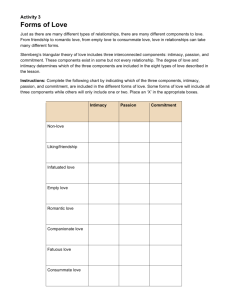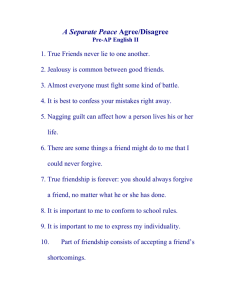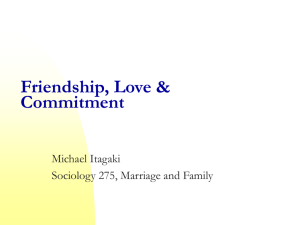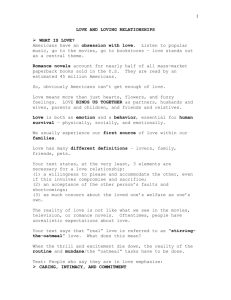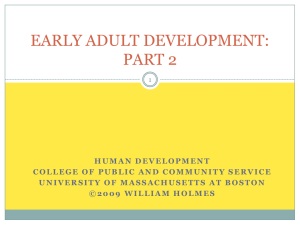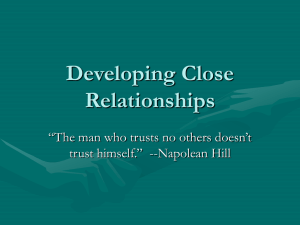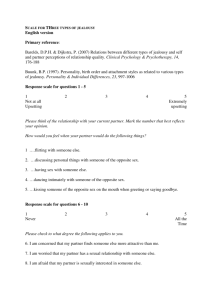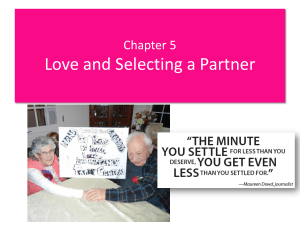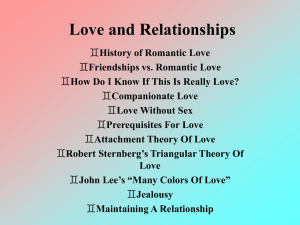Friendship, Love, and Commitment: A Presentation
advertisement
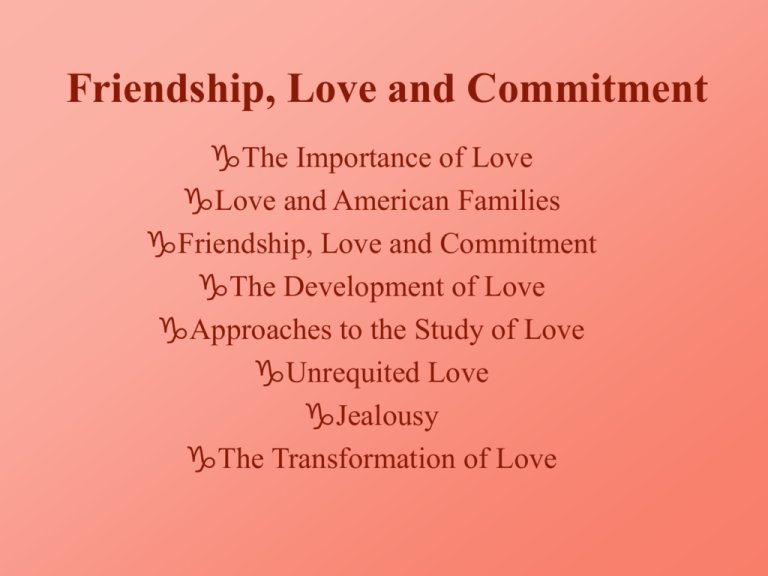
Friendship, Love and Commitment The Importance of Love Love and American Families Friendship, Love and Commitment The Development of Love Approaches to the Study of Love Unrequited Love Jealousy The Transformation of Love The Importance of Love • • • • Love is essential to our lives. Love is both a feeling and an activity. Love encompasses opposites. Understanding how love works. Love and American Families • Love is the basis for family formation in the United States. • Love becomes the foundation upon which manage is built and the criterion for spousal selection. • There are two distinct but related cultural beliefs about the character of love. • Americans tend to marry people much like themselves, a pattern known as homogamy. Friendship, Love and Commitment • 1. Friendship is the foundation for love and commitment. • 2. Love reflects the positive factors, such as caring and attraction, that draw people together and sustain them in a relationship. • 3. Commitment reflects the stable factors (love, obligations, social pressure) that help maintain the relationship for better or worse. • ~Although love and commitment are related, they are not necessarily connected; one can exist without the other. • ~Secure adults average length of a relationship is 10 years. • ~Our commitments seem to be affected by several factors that can strengthen or weaken the relationship. • 1. We have a tendency to look at romantic and marital relationships from a cost-benefit perspective. • 2. Normative inputs for relationships are the values that you and your partner hold about love, relationships, marriage, and family: These values can either sustain or detract from a commitment. • 3. The structural constraints of a relationship will add to or detract from commitment. • 4. Commitments are more likely to endure in marriage than in cohabiting or dating relationships, which tend to be shorter. • 5. Commitments are more likely to last in heterosexual relationships than in gay or lesbian relationships. • 6. Ethnicity may be the greatest predictor of satisfaction and commitment to a friendship. • 7. An enduring marriage is not necessarily a happy marriage. • ~Friendship and love bind us together, provide emotional sustenance, buffer us against stress, and help to preserve our physical and mental wellbeing. The Wheel Theory • ~Reiss's wheel theory of love suggests that love develops and is maintained through four processes: (1) rapport, (2) self-revelation, (3) mutual dependency, and (4) fulfillment of the need for intimacy. • ~The wheel theory emphasizes interdependence, bi-directionality, and role conceptions. How Do I Love Thee? • John Lee described six basic styles of love: eros, mania, ludus, storge, agape, and pragma. • Eros- Erotic lovers delight in the tactile, the sensual, the immediate; they are attracted to beauty. Their love burns brightly but soon flickers and dies. • Ludus- For ludic lovers, love is a game, something to play at rather than to become deeply involved in. Love is for fun, casual, carefree and often careless. • Storage- Is the love between companions. It begins gradually as a friendship and then gradually deepens into love. • Mania- The slightest sign of affection brings ecstasy for a short while, only to have it disappear. Manic love is a roller-coaster. • Agape- Is patient, selfless, and undemanding; it does not need to be reciprocated. It is the love of missionaries, and saints more than that of worldly couples. • Pragma- Logical in their approach. They look for partners that are compatible with their own and can meet their needs. Such as the person who meets their criteria, erotic or manic feeling develop. • 1. Lee believes that to have a mutually satisfying love affair, a person has to find a partner who shares the same style and definition of love. • 2. The more different two people are in their styles of loving, the less likely it is that they will understand each other's love. • ~The triangular theory of love emphasizes the dynamic quality of love relationships and sees love as composed of intimacy, passion, and decision/commitment. • 1. Intimacy refers to warm, close feelings of bonding in a relationship. • 2. Passion refers to the elements of romance, attraction, and sexuality in a relationship. • 3. The short-term decision/commitment refers to deciding you love someone; the long-term decision/commitment involves the maintenance of love. • 4. Eight ways of classifying love include: liking, romantic love, infatuation, fatuous love, empty love, companionate love, consummate love, and nonlove. • ~Attachment theory maintains that the degree and quality of attachments we experience in early life influence our later relationships. Unrequited Love • ~Unrequited love, love that is not returned, is a common experience. • ~According to Arthur Aron and his colleagues, there are three different attachment styles underlying the experience of unrequited love. • 1. The Cyrano style involves the desire to have a romantic relationship with a person regardless of how hopeless the love is. • 2. The Giselle style misperceives the relationship to be more than it really is. • 3. The Don Quixote style involves the general desire to be in love, regardless of whom one loves. The Green-Eyed Monster • ~Rather than a sign of love, provoking jealousy proves nothing except that the other person can be made jealous. • 1. Jealousy may be a more accurate measure of insecurity and possessiveness than love. • ~Jealousy is an aversive response that occurs due to a partner's real, imagined, or likely involvement with a third person. • ~Jealousy is a painful experience during which we feel less attractive and acceptable to our partner. • ~Jealousy acts as a boundary marker by determining how, to what extent, and in what manner others can interact with members of the relationship and vice versa. • ~Men experience jealousy when they feel their partner is sexually involved with another man: Women experience jealousy over intimate issues. • ~Managing jealousy requires the ability to communicate, the recognition by each partner of the feelings and motivations of the other, and a willingness to reciprocate and compromise. From Passion to Intimacy • Passionate love is unstable; romantic love is usually transformed or replaced by a quieter, more enduring love based on intimacy. • 1. Initially, intimacy increases rapidly. • 2. Passion is subject to habituation. • 3. In becoming habituated, we also become dependent. • 4. Commitment grows more slowly than intimacy or passion. • 5. Intimacy- The disappearance or transformation of passionate love is often experienced as a crisis. • 6. Romantic love may be highest during the early part of marriage. • 7. In later life, romantic love may play an important role in alleviating the stressors. • ~Intimate love is enduring; it is based on commitment, caring, and self-disclosure. • 1. Commitment is the determination to continue a relationship or marriage; it is based on conscious choice rather than on feelings. • 2. Caring is placing another's needs before your own; it entails an I-Thou relationship as opposed to an I-it relationship. • 3. Self-disclosure (revealing our hopes, fears, and everyday thoughts) deepens our understanding of each other. • 4. Together, commitment, caring, and selfdisclosure help transform love, but the most important means of sustaining love is our words and actions.
